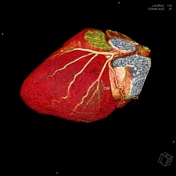Circumflex artery
Updates to Article Attributes
The circumflex artery (Cx) is one of the two major coronary arteries that arise from the bifurcation of the left main coronary artery (the other branch being the left anterior descending (LAD) artery).
Terminology
The circumflex artery can be referred to by multiple terms:
- circumflex artery (Cx)
- ramus circumflex artery (RCx)
- left circumflex artery (LCx)
Often it is colloquially called the 'circ'.
Gross anatomy
The artery travels in the left atrioventricular groove between the left ventricle and left atrium. The artery is located in the epicardium.
The circumflex artery gives off up to three obtuse marginal branches and may give off a left posterolateral branch and may supply the inferior interventricular artery (see variant anatomy below).
In angiography and CTCA, the LCx is often describes as having proximal and distal segments:
- proximal segment: from the LMCA bifurcation (LCx origin) to the origin of the first marginal artery (M1)
- distal segment: from the M1 origin to the termination
Supply
Branches of the circumflex artery supply the lateral and posterolateral walls of the left ventricle.
Coronary dominance
Most hearts are right dominant where the posterior descending artery (PDA) is supplied by the right coronary artery (RCA). However up to 20% of hearts may be left dominant, where the PDA is supplied by the LAD or LCx or codominant, where a single or duplicated PDA is supplied by branches of both the RCA and LAD/LCx.
For a more in depth discussion of coronary dominance, see the article coronary arterial dominance.
Variant anatomy
- in a left-dominant circulation, the circumflex artery supplies the inferior interventricular artery, instead of the right coronary artery
- in a co-dominant circulation, both the circumflex artery and RCA supply the inferior interventricular artery (or a duplicated inferior interventricular artery)
- the RCA supplying the inferior interventricular artery and the circumflex artery supplying a large left posterolateral branch has also been considered co-dominant
- the circumflex artery may arise separately off the left coronary cusp from the LAD (i.e. no left main coronary artery)
- the circumflex artery may have an aberrant origin off the right coronary cusp
Related pathology
- coronary artery disease: occlusion of the circumflex artery leading to myocardial infarction or sudden cardiac death
-</ul><p>Often it is colloquially called the 'circ'.</p><h4>Gross anatomy</h4><p>The artery travels in the left <a href="/articles/atrioventricular-groove">atrioventricular groove</a> between the left ventricle and left atrium. The artery is located in the <a href="/articles/epicardium">epicardium</a>.</p><p>The circumflex artery gives off up to three <a href="/articles/obtuse-marginal-artery">obtuse marginal branches</a> and may give off a <a href="/articles/left-posterolateral-branch">left posterolateral branch</a> and may supply the inferior interventricular artery (see variant anatomy below).</p><ul></ul><h4>Supply</h4><p>Branches of the circumflex artery supply the lateral and posterolateral walls of the <a href="/articles/left-ventricle">left ventricle</a>.</p><h4>Coronary dominance</h4><p>Most hearts are right dominant where the posterior descending artery (PDA) is supplied by the right coronary artery (RCA). However up to 20% of hearts may be left dominant, where the PDA is supplied by the LAD or LCx or codominant, where a single or duplicated PDA is supplied by branches of both the RCA and LAD/LCx.</p><p>For a more in depth discussion of coronary dominance, see the article <a href="/articles/coronary-arterial-dominance">coronary arterial dominance</a>.</p><h4>Variant anatomy</h4><ul>- +</ul><p>Often it is colloquially called the 'circ'.</p><h4>Gross anatomy</h4><p>The artery travels in the left <a href="/articles/atrioventricular-groove">atrioventricular groove</a> between the <a href="/articles/left-ventricle">left ventricle</a> and <a href="/articles/left-atrium-1">left atrium</a>. The artery is located in the <a href="/articles/epicardium">epicardium</a>.</p><p>The circumflex artery gives off up to three <a href="/articles/obtuse-marginal-artery">obtuse marginal branches</a> and may give off a <a href="/articles/left-posterolateral-branch">left posterolateral branch</a> and may supply the inferior interventricular artery (see variant anatomy below).</p><p>In angiography and CTCA, the LCx is often describes as having proximal and distal segments:</p><ul>
- +<li>proximal segment: from the LMCA bifurcation (LCx origin) to the origin of the first marginal artery (M1)</li>
- +<li>distal segment: from the M1 origin to the termination</li>
- +</ul><h4>Supply</h4><p>Branches of the circumflex artery supply the lateral and posterolateral walls of the <a href="/articles/left-ventricle">left ventricle</a>.</p><h4>Coronary dominance</h4><p>Most hearts are right dominant where the posterior descending artery (PDA) is supplied by the right coronary artery (RCA). However up to 20% of hearts may be left dominant, where the PDA is supplied by the LAD or LCx or codominant, where a single or duplicated PDA is supplied by branches of both the RCA and LAD/LCx.</p><p>For a more in depth discussion of coronary dominance, see the article <a href="/articles/coronary-arterial-dominance">coronary arterial dominance</a>.</p><h4>Variant anatomy</h4><ul>
Image 2 CT (C+ arterial phase) ( update )

Image 3 DSA (angiography) (RAO 20 Caudal 20 (for LCA)) ( update )








 Unable to process the form. Check for errors and try again.
Unable to process the form. Check for errors and try again.